andare
Well-known member
Hi,
I'm trying to remove a 47uF electrolytic capacitor from a Minnow PCB that is 99% populated. Silly me soldered it where the 4.7uF cap goes...
I'd like to salvage this build because it is expensive and complicated for me but solder sucker and my puny 0.5mm solder wick aren't working.
What is your go-to method from removing through-hole components from a PCB?
Should I just use wider solder wick? 2mm?
Thanks in advance!
I'm trying to remove a 47uF electrolytic capacitor from a Minnow PCB that is 99% populated. Silly me soldered it where the 4.7uF cap goes...
I'd like to salvage this build because it is expensive and complicated for me but solder sucker and my puny 0.5mm solder wick aren't working.
What is your go-to method from removing through-hole components from a PCB?
Should I just use wider solder wick? 2mm?
Thanks in advance!
Last edited:



